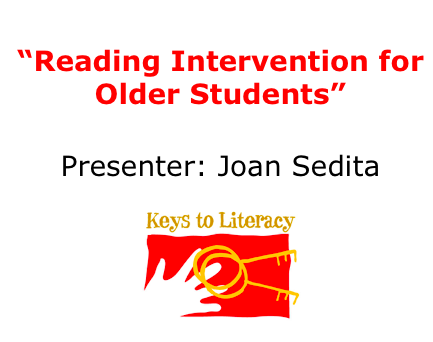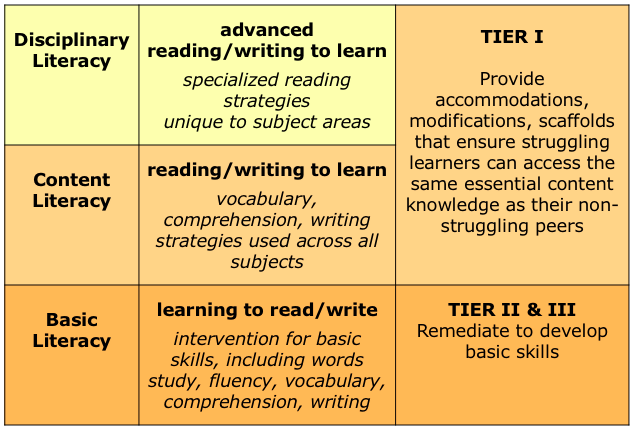Reading Intervention for Older Struggling Students

In the last few months I have seen a growing interest in adolescent literacy. This includes content literacy instruction for all students that is integrated across subject areas, as well as intervention instruction for older students who struggle with reading and writing. Between 2005 and 2015, a number of adolescent literacy research reports were published based on meta-analyses of research on effective practices for teaching reading and writing to older students, and the website AdLit.org was also launched (see the reference list). The visual below is a slide from a recent workshop I delivered about this topic. At that time schools and districts began addressing the literacy needs of older students, but over the past few years, literacy initiatives shifted focus primarily on the needs of PreK to grade 3 students. While this focus is essential, even if students leave grade 3 with grade-level reading and writing skills there is no guarantee that their skills will continue to grow to meet the demands of upper grades. Also, consider that the 2019 National Assessment of Education Progress reading scores were down from the 2017 assessment, with only 35% of 4th graders and 34% of 8th graders scoring at or above proficient.

If you are an educator who works with older students, the good news is that the focus is beginning to shift to grades 4-12. A number of state departments of education (e.g., Colorado, Ohio, Arkansas, Massachusetts) are offering professional development and grant funding to grade bands beyond the elementary level. And from personal experience, the number of inquiries for professional development about adolescent literacy coming in to Keys to Literacy is significantly growing. Keys to Literacy has several P.D. programs designed for content literacy instruction this grade range: The Key Comprehension Routine, The Key Vocabulary Routine, and Keys to Content Writing.
For this post I want to focus on some resources for reading and writing instruction for older students who struggle with reading and writing. The first is the recording of a 45-minute free webinar I recently did that is available at the Keys to Literacy Free Resources website titled “Reading Intervention for Older Readers” that has a companion Padlet with handouts and resources. The second is a series of virtual workshops I recently did for the Ohio Department of Education about reading interventions for older students that they have posed on Vimeo. Part 1 is titled Identifying Student Needs Part 2 is titled Matching Students to Interventions and Part 3 is titled Progress Monitoring.
In an earlier blog post (January 13, 2021) there are links to a variety of adolescent literacy research reports and resources, including a copy of a chapter I wrote in 2011 titled Adolescent Literacy: Addressing the Needs of Students in Grades 4-12.
Levels of Instruction
What kinds of instruction do older struggling readers need? The chart below identifies 3 categories of instruction. The most obvious category for struggling students is Basic Literacy. Depending on a student’s individual profile, appropriate intervention instruction might need to focus on any of the major reading components (i.e., phonemic awareness, phonics, fluency, vocabulary, comprehension) and writing skills as basic as sentence structure. Diagnostic and progress monitoring assessments are needed to make intervention instructional decisions. We also know that for intervention to be effective at these grade levels, the instruction must be explicit, intensive in terms of time and guided practice, in small groups, and taught be trained intervention educators.
However, even if older struggling students receive a significant amount of intervention instruction, they will still spend most of their school day in general education, content area classess. This is why all teachers are needed if we are going to truly improve the literacy skills of these students. All students benefit from disciplinary and content literacy instruction that is embedded in subject areas (i.e., Tier I Core Instruction). Content literacy includes more basic vocabulary, comprehension and writing strategies that can be used in any subject area. Examples include summarizing, note taking, word knowledge checklists for vocabulary, and graphic organizers for planning before writing. Disciplinary literacy includes teaching students advanced literacy skills that are unique to a particular subject. This is sometimes referred to as teaching students to read and write like a mathematician, a scientist, or historian. Content area teachers will need to differentiate and scaffold their content literacy instruction to support struggling students.

Literacy Planning for Upper Grades
Schools and districts that are looking to address the needs of older students who struggle with reading and writing should consider developing literacy plans that take stock of what already exists in terms of literacy assessment and data use, core content literacy instruction, intervention instruction, literacy resources, and literacy professional development. As part of a literacy planning process, a school or district uses this information to establish goals and action steps that make up a long-term literacy plan for meeting the needs of students in grades 4-12. Keys to Literacy offers literacy planning support. To learn more about literacy planning in middle and high school, watch this recording of a workshop I did in 2020 for the Ohio Department of Education.
References, Reports
- Biancarosa, G., & Snow, C.E. (2004).”Reading Next: A Vision for Action and Research in Middle and High School Literacy”. A report from the Carnegie Corporation of New York.
- Graham, S., & Perin, D. (2007). Writing next: Effective strategies to improve the writing of adolescents in middle and high schools – A report to Carnegie Corporation of New York. Washington, DC: Alliance for Excellent Education.
- Graham, S.. and Hebert, M.A. (2010). Writing to read: Evidence for how writing can improve reading. A Carnegie Corporation Time to Act Report. Washington, DC: Alliance for Excellent Education
- Heller, R., & Greenleaf, C.L. (2007). “Literacy Instruction in the Content Areas: Getting to the Core of Middle and High School Improvement.” Alliance for Excellent Education.
- Kamil, M.L., Borman, G.D., Dole, J., Kral, C.C., Salinger, T., and Torgesen, J. (2008). Improving adolescent literacy: Effective classroom and intervention practices: A Practical Guide (NCEE #2008-4027). Washington, DC: National Center for Education Evaluation and Regional Assistance, Institute of Education Sciences, U.S. Department of Education.
- Murray, C.S., Wexler, J., Vaughn, S., Roberts, G., Klingler-Tackett, K., Boardman A.G., Miller, D., Kosanovich, M. (2010). Effective Instruction for Adolescent Struggling Readers: Professional Development Module – Second Edition. Center on Instruction. RMC Research Corporation.
- National Institute for Literacy (2007). What content-area teachers should know about adolescent literacy. Washington, DC:National Institute of Child Health and Human Development.

 Joan Sedita is the founder of Keys to Literacy and author of the Keys to Literacy professional development programs. She is an experienced educator, nationally recognized speaker and teacher trainer. She has worked for over 35 years in the literacy education field and has presented to thousands of teachers and related professionals at schools, colleges, clinics, and professional conferences.
Joan Sedita is the founder of Keys to Literacy and author of the Keys to Literacy professional development programs. She is an experienced educator, nationally recognized speaker and teacher trainer. She has worked for over 35 years in the literacy education field and has presented to thousands of teachers and related professionals at schools, colleges, clinics, and professional conferences.
Thank you so much for sharing these amazing resources. I have learned so much from your webinars.
You are most welcome!
If we would like to complete several of these webinars are there certificates that we can print and submit to admin for hours in our professional development plans?
Sorry, but only the folks who attended the live webinars received certificates of completion.
Hello,
I am a qualified Primary teacher in England who was supposed to have sort of retired 16 months ago.
I have been asked by a teacher friend to tutor reading to 11, 12, 13 and 14 year olds.
Some of them are very low ability and still need phonics daily to help them.
These are older children who may not respond to some of the activities we use to teach younger children to read. It’s not just phonics, I want to encourage reading as a wonderful thing for them and explore characters etc.
What activities so you suggest please?
I wont meet the children till Monday (my first day) They will be in groups of four, one hour every day for 3 weeks.
Can you advise where I can get some ideas that might work with them please?
The reason older students have difficulty with reading varies from student to student… there is no “one-size-fits-all” set of instructional practices. There are many who still struggle with the foundational skills of decoding and fluency, along with gaps in vocabulary knowledge and a lack of comprehension strategies they can use to support reading comprehension. You are correct to point out that many of the teaching materials for phonics are too childish for older students, and this can turn them off. Fortunately, there are phonics intervention programs for older students that are developmentally appropriate. Wilson Language and The Really Great Reading Company are examples. Whether they have decoding issues or not, almost all struggling students benefit from explicit instruction in comprehension strategies, writing about reading, and instruction for academic vocabulary. You may find of the free webinars and materials at the Keys to Literacy website helpful in terms of giving you instructional suggestions in these topics. There is also the AdLit.org website that has great resources, and a Facebook Group called “The Science of Reading: Grade 3 and Beyond” that often posts great teaching resources for older students. Finally, in response to your comment about wanting to encourage them to read… my experience is that older students who have difficulty with reading have had years of frustration and lack of self-esteem in school as a result. It’s hard to get someone to like to do something (like reading) if they feel this way. Focus the precious tutoring time you have with them on teaching specific skills, with guided practice for applying these skills to reading text. When you do this you give them the tools to be able to read, which is a necessary first step to eventually learning how to enjoy reading!